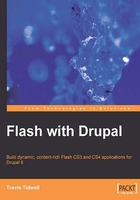
What this book covers
Chapter 1 sets the stage for the reader to learn how Flash and Drupal can combine to create a dynamic, content-rich experience for our users. We will learn how to embed Flash applications within Drupal, as well as learn about some important modules that make it easier to work with Flash in Drupal.
Chapter 2 builds a "Hello World" application. We will say hello to the world in Flash using Drupal-driven content. However, unlike any other "Hello World" tutorial, we will learn the important concepts of asynchronous programming and how that relates to working with Drupal content in Flash.
Chapter 3 covers how to add custom content to our Flash applications using the popular Content Construction Kit (CCK). We will illustrate this concept by building a hypothetical Recipe Flash application designed for a Drupal cooking web site.
Chapter 4 shows us how to use Drupal managed images to give our application a little visual flare as a visually stunning Flash application would not be complete without the integration of images. We will build on from the previous chapter by adding an image to our Recipe Flash application.
Chapter 5 explores how to use Drupal to manage a list of audio nodes and also builds a Flash application to play that music. When it comes to multimedia, Flash is the portal of choice for playing audio on a web sites.
Chapter 6 expands our custom media player to not only play music, but also show Flash videos managed from our Drupal web site, which is built onto the concept from the previous chapter. In addition, we will learn some important concepts of object-oriented practices while we reuse common components to build a media player for Drupal.
Chapter 7 explains the basics of how to take an existing Flash application and break apart the components for remote communication. We achieve this by first abstracting out separate functionalities into two separate components, and then laying the foundation for a communication gateway between the two different components. This is an essential first step to create a robust and easily maintained system, where Flash applications can be separated on a Drupal web site, thus implementing a hybrid Flash integration approach.
Chapter 8 creates the necessary components required to implement the hybrid approach. This chapter focuses on creating the bridge between two different Flash applications. Once we create this bridge, we will have the ability to control our media from a remote Flash application. In other words, we will be building a remote control for our media player that can be placed anywhere on the page, separate from the media player.
Chapter 9 builds a media player whose playlist is driven from the power of the Drupal Views module. Arguably, the most important aspect of any content-rich web site is its ability to build lists of each piece of content in a meaningful manner. The Drupal Views module gives the administrator the ability to manage the contents of their site in a meaningful list of content to present to the users. By combining this power within Flash, we can learn how to create a playlist of video nodes for our custom media player.
Chapter 10 shows how to utilize user management within a Flash application by building a User Login Flash widget. One of the most important aspects of the Drupal CMS is its ability to manage its users and protect the content of that site using a permission-based role system.
Chapter 11 shows how to add content to our Drupal web site while at the same time keep our data safe from malicious software. Not only can Flash be used to show Drupal content, but it can also be utilized to add and manipulate Drupal content from a remote Flash application.
Chapter 12 will sum up all lessons learned in this book by building a five-star voting mechanism in Flash. We will learn how to build a custom Voting Service as well as create our very own Flash driven five-star voter compatible with the popular FiveStar module.